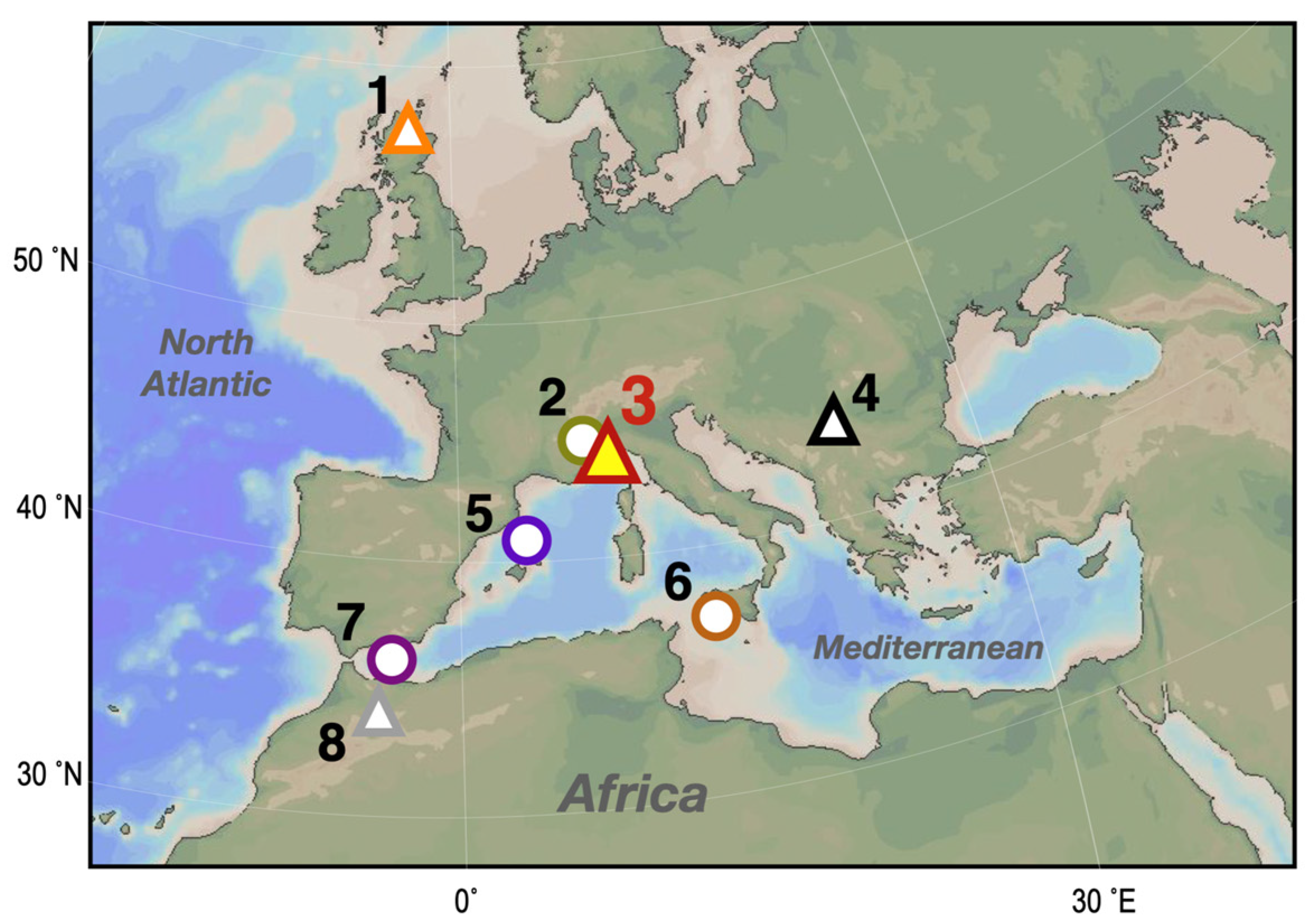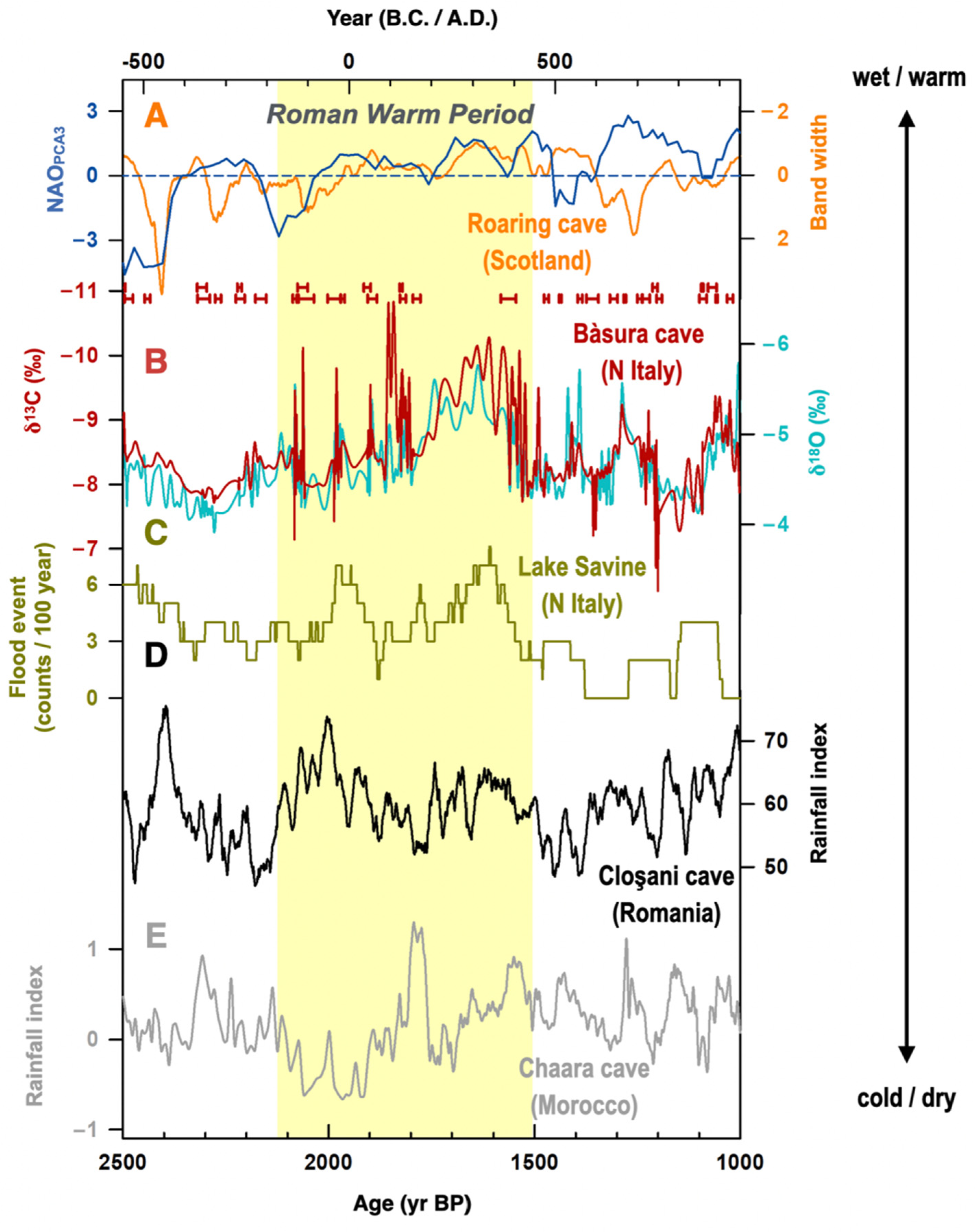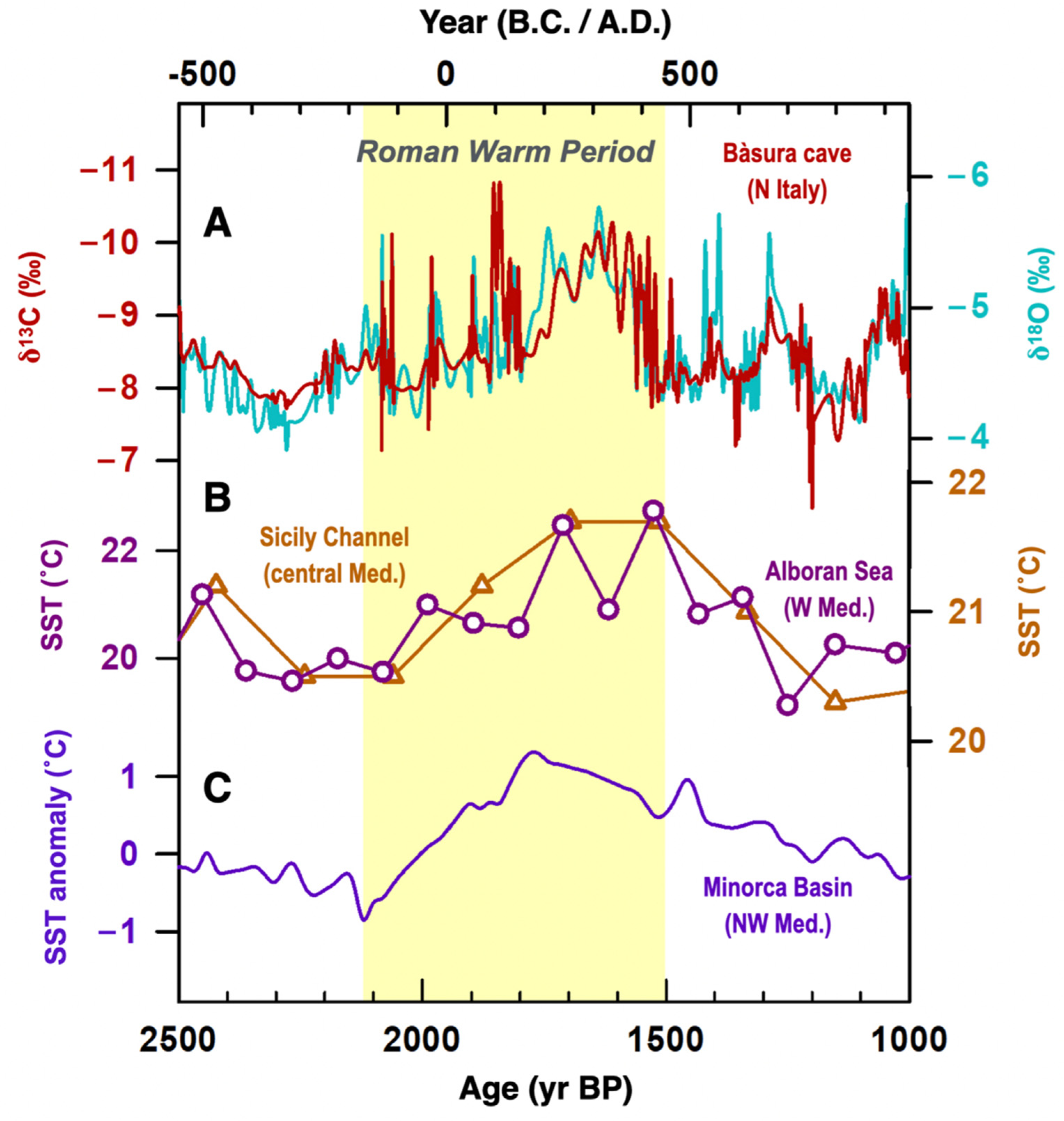Stalagmite-Inferred Climate in the Western Mediterranean during the Roman Warm Period
Abstract
:1. Introduction
2. Material and Methods
2.1. Cave and Regional Settings
2.2. Samples, U-Th Dating and Isotope Measurements
3. Results and Discussion
3.1. Carbon Isotope Results
3.2. Interpretation of Carbon Isotope Variations
3.3. Hydroclimate Changes during the Roman Warm Period
4. Conclusions
Supplementary Materials
Author Contributions
Funding
Institutional Review Board Statement
Informed Consent Statement
Data Availability Statement
Acknowledgments
Conflicts of Interest
References
- Giorgi, F. Climate change hot-spots. Geophys. Res. Lett. 2006, 33, L08707. [Google Scholar] [CrossRef]
- Screen, J.A.; Simmonds, I. Caution needed when linking weather extremes to amplified planetary waves. Proc. Natl. Acad. Sci. USA 2013, 110, E2327. [Google Scholar] [CrossRef] [Green Version]
- Mahlstein, I.; Daniel, J.S.; Solomon, S. Pace of shifts in climate regions increases with global temperature. Nat. Clim. Chang. 2013, 3, 739–743. [Google Scholar] [CrossRef]
- Stadtherr, L.; Coumou, D.; Petoukhov, V.; Petri, S.; Rahmstorf, S. Record Balkan floods of 2014 linked to planetary wave resonance. Sci. Adv. 2016, 2, 012009. [Google Scholar] [CrossRef] [Green Version]
- DeMenocal, P. Cultural responses to climate change during the late Holocene. Science 2001, 292, 667–674. [Google Scholar] [CrossRef]
- Büntgen, U.; Tegel, W.; Nicolussi, K.; McCormick, M.; Frank, D.; Trouet, V.; Kaplan, J.O.; Herzig, F.; Heussner, K.-U.; Wanner, H.; et al. 2500 years of European climate variability and human susceptibility. Science 2011, 331, 578–582. [Google Scholar] [CrossRef] [Green Version]
- Bar-Matthews, M.; Ayalon, A. Mid-Holocene climate variations revealed by high-resolution speleothem records from Soreq Cave, Israel and their correlation with cultural changes. Holocene 2011, 21, 163–171. [Google Scholar] [CrossRef]
- Cullen, H.M.; de Menocal, P.B.; Hemming, S.; Brown, F.H.; Guilderson, T.; Sirocko, F. Climate change and the collapse of the Akkadian empire: Evidence from the deep sea. Geology 2000, 28, 379–382. [Google Scholar] [CrossRef] [Green Version]
- Drysdale, R.; Zanchetta, G.; Hellstrom, J.; Maas, R.; Fallick, A.; Pickett, M.; Cartwright, I.; Piccini, L. Late Holocene drought responsible for the collapse of Old World civilizations is recorded in an Italian cave flowstone. Geology 2006, 34, 101–104. [Google Scholar] [CrossRef] [Green Version]
- Kaniewski, D.; van Campo, E.; Guiot, J.; le Burel, S.; Otto, T.; Baeteman, C. Environmental roots of the Late Bronze Age crisis. PLoS ONE 2013, 8, e71004. [Google Scholar] [CrossRef] [Green Version]
- Lamb, H.H. Climate: Present, Past and Future—V.2: Climatic History and the Future; Methuen: London, UK; Barnes and Noble: New York, NY, USA, 1977; p. 837. [Google Scholar]
- Patterson, W.P.; Dietrich, K.A.; Holmden, C.; Andrews, J.T. Two millennia of North Atlantic seasonality and implications for Norse colonies. Proc. Natl. Acad. Sci. USA 2010, 107, 5306–5310. [Google Scholar] [CrossRef] [PubMed] [Green Version]
- McCormick, M.; Büntgen, U.; Cane, M.A.; Cook, E.R.; Harper, K.; Huybers, P.; Litt, T.; Manning, S.W.; Mayewski, P.A.; More, A.F.M.; et al. Climate change during and after the Roman Empire: Reconstructing the past from scientific and historical evidence. J. Interdiscip. Hist. 2012, 43, 169–220. [Google Scholar] [CrossRef] [Green Version]
- Frisia, S.; Borsato, A.; Spötl, C.; Villa, I.M.; Cucchi, F. Climate variability in the SE Alps of Italy over the past 17,000 years reconstructed from a stalagmite record. Boreas 2005, 34, 445–455. [Google Scholar] [CrossRef]
- Esper, J.; Frank, D.C.; Timonen, M.; Zorita, E.; Wilson, R.J.S.; Luterbacher, J.; Holzkämper, S.; Fischer, N.; Wagner, S.; Nievergelt, D.; et al. Orbital forcing of tree-ring data. Nat. Clim. Chang. 2012, 2, 862–866. [Google Scholar] [CrossRef]
- Magny, M.; de Beaulieu, J.-L.; Drescher-Schneider, R.; Vannière, B.; Walter-Simonnet, A.-V.; Miras, Y.; Millet, L.; Bossuet, G.; Peyron, O.; Brugiapaglia, E.; et al. Holocene climate changes in the central Mediterranean as recorded by lake-level fluctuations at Lake Accesa (Tuscany, Italy). Quat. Sci. Rev. 2007, 26, 1736–1758. [Google Scholar] [CrossRef]
- Migowski, C.; Stein, M.; Prasad, S.; Negendank, J.F.W.; Agnon, A. Holocene climate variability and cultural evolution in the Near East from the Dead Sea sedimentary record. Quat. Res. 2006, 66, 421–431. [Google Scholar] [CrossRef]
- Zanchetta, G.; Drysdale, R.N.; Hellstrom, J.C.; Fallick, A.E.; Isola, I.; Gagan, M.K.; Pareschi, M.T. Enhanced rainfall in the Western Mediterranean during deposition of sapropel S1: Stalagmite evidence from Corchia cave (Central Italy). Quat. Sci. Rev. 2007, 26, 279–286. [Google Scholar] [CrossRef] [Green Version]
- Margaritelli, G.; Cacho, I.; Català, A.; Barra, M.; Bellucci, L.G.; Lubritto, C.; Rettori, R.; Lirer, F. Persistent warm Mediterranean surface waters during the Roman period. Sci. Rep. 2020, 10, 10431. [Google Scholar] [CrossRef]
- Paolo, C.; Romano, M.; Salvador, I.; Avanzini, M. Reviewing the upper Pleistocene human footprints from the ‘Sala dei Misteri’ in the Grotta della Bàsura (Toirano, northern Italy) cave: An integrated morphometric and morpho-classificatory approach. Quat. Sci. Rev. 2017, 169, 50–64. [Google Scholar] [CrossRef]
- Hu, H.-M.; Trouet, V.; Spötl, C.; Tsai, H.-C.; Chien, W.-Y.; Sung, W.-H.; Michel, V.; Yu, J.-Y.; Valensi, P.; Jiang, X.; et al. Tracking the Westerly Wind Directions over Europe since the Middle Holocene. Sci. Adv. 2022; Submitted for Publication. [Google Scholar]
- Baker, A.C.; Hellstrom, J.; Kelly, B.F.J.; Mariethoz, G.; Trouet, V. A composite annual-resolution stalagmite record of North Atlantic climate over the last three millennia. Sci. Rep. 2015, 5, 10307. [Google Scholar] [CrossRef] [Green Version]
- Sabatier, P.; Bruno, W.; Francesco, F.G.; Fanny, M.; Jérôme, P.; Anne-Lise, D.; Adeline, B.; Wentao, C.; Cécile, P.; Jean-Louis, R.; et al. 6-kyr record of flood frequency and intensity in the western Mediterranean Alps—Interplay of solar and temperature forcing. Quat. Sci. Rev. 2017, 170, 121–135. [Google Scholar] [CrossRef]
- Warken, S.F.; Fohlmeister, J.; Schröder-Ritzrau, A.; Constantin, S.; Spötl, C.; Gerdes, A.; Esper, J.; Frank, N.; Arps, J.; Terente, M.; et al. Reconstruction of late Holocene autumn/winter precipitation variability in SW Romania from a high-resolution speleothem trace element record. Earth Planet. Sci. Lett. 2018, 499, 122–133. [Google Scholar] [CrossRef]
- Rodrigo-Gámiz, M.; Martínez-Ruiz, F.; Rampen, S.W.; Schouten, S.; Sinninghe Damsté, J.S. Sea surface temperature variations in the western Mediterranean Sea over the last 20 kyr: A dual-organic proxy (UK’37 and LDI) approach. Paleoceanography 2014, 29, 87–98. [Google Scholar] [CrossRef] [Green Version]
- Miglietta, M.M.; Moscatello, A.; Conte, D.; Mannarini, G.; Lacorata, G.; Rotunno, R. Numerical analysis of a Mediterranean “hurricane” over south-eastern Italy: Sensitivity experiments to sea surface temperature. Atmos. Res. 2011, 101, 412–426. [Google Scholar] [CrossRef]
- Cisneros, C.; de Caballero, E. Paleoclimate Reconstruction during MIS 5a Based on a Speleothem from Nerja Cave, Málaga, South Spain. Nat. Sci. 2013, 5, 533–540. [Google Scholar]
- Ait Brahim, Y.; Wassenburg, J.A.; Sha, L.; Cruz, F.W.; Deininger, M.; Sifeddine, A.; Bouchaou, L.; Spötl, C.; Edwards, R.L.; Cheng, H. North Atlantic ice-rafting, ocean and atmospheric circulation during the Holocene: Insights from western Mediterranean speleothems. Geophys. Res. Lett. 2019, 46, 7614–7623. [Google Scholar] [CrossRef]
- Shen, C.-C.; Cheng, H.; Edwards, R.L.; Moran, S.B.; Edmonds, H.N.; Hoff, J.A.; Thomas, R.B. Measurement of attogram quantities of 231Pa in dissolved and particulate fractions of seawater by isotope dilution thermal ionization mass spectroscopy. Anal. Chem. 2003, 75, 1075–1079. [Google Scholar] [CrossRef]
- Shen, C.-C.; Li, K.-S.; Sieh, K.; Natawidjaja, D.; Cheng, H.; Wang, X.; Edwards, R.L.; Lam, D.D.; Hsieh, Y.-T.; Fan, T.-Y.; et al. Variation of initial 230Th/232Th and limits of high precision U–Th dating of shallow-water corals. Geochim. Cosmochim. Acta 2008, 72, 4201–4223. [Google Scholar] [CrossRef]
- Shen, C.-C.; Wu, C.-C.; Cheng, H.; Lawrence, E.R.; Hsieh, Y.-T.; Gallet, S.; Chang, C.-C.; Li, T.-Y.; Lam, D.D.; Kano, A.; et al. High-precision and high-resolution carbonate 230Th dating by MC-ICP-MS with SEM protocols. Geochim. Cosmochim. Acta 2012, 99, 71–86. [Google Scholar] [CrossRef]
- Scholz, D.; Hoffmann, D.L. StalAge—An algorithm designed for construction of speleothem age models. Quat. Geochronol. 2011, 6, 369–382. [Google Scholar] [CrossRef]
- Olsen, J.; Anderson, N.J.; Knudsen, M.F. Variability of the North Atlantic Oscillation over the past 5200 years. Nat. Geosci. 2012, 5, 808–812. [Google Scholar] [CrossRef]
- Hendy, C. The isotopic geochemistry of speleothems—I. The calculation of the effects of different modes of formation on the isotopic composition of speleothems and their applicability as palaeoclimatic indicators. Geochim. Cosmochim. Acta 1971, 35, 801–824. [Google Scholar] [CrossRef]
- Dorale, J.A.; Liu, Z. Limitations of Hendy test criteria in judging the paleoclimatic suitability of speleothems and the need for replication. J. Cave Karst Stud. 2009, 71, 73–80. [Google Scholar]
- Amundson, R.; Stern, L.; Baisden, T.; Wang, Y. The isotopic composition of soil and soil-respired CO2. Geoderma 1998, 82, 83–114. [Google Scholar] [CrossRef]
- Fohlmeister, J.; Voarintsoa, N.R.G.; Lechleitner, F.A.; Boyd, M.; Brandtstätter, S.; Jacobson, M.J.; Oster, J.L. Main controls on the stable carbon isotope composition of speleothems. Geochim. Cosmochim. Acta 2020, 279, 67–87. [Google Scholar] [CrossRef]
- Fohlmeister, J.; Arps, J.; Spötl, C.; Schröder-Ritzrau, A.; Plessen, B.; Günter, C.; Frank, N.; Trüssel, M. Carbon and oxygen isotope fractionation in the water-calcite-aragonite system. Geochim. Cosmochim. Acta 2018, 235, 127–139. [Google Scholar] [CrossRef] [Green Version]
- Baker, A.; Ito, E.; Smart, P.L.; McEwan, R.F. Elevated and variable values of 13C in speleothems in a British cave system. Chem. Geol. 1997, 136, 263–270. [Google Scholar] [CrossRef]
- McDermott, F. Palaeo-climate reconstruction from stable isotope variations in speleothems: A review. Quat. Sci. Rev. 2004, 23, 901–918. [Google Scholar] [CrossRef]
- Rudzka, D.; McDermott, F.; Baldini, L.M.; Fleitmann, D.; Moreno, A.; Stoll, H. The coupled δ13C-radiocarbon systematics of three Late Glacial/early Holocene speleothems; insights into soil and cave processes at climatic transitions. Geochim. Cosmochim. Acta 2011, 75, 4321–4339. [Google Scholar] [CrossRef]
- Columbu, A.; Audra, P.; Gázquez, F.; D’Angeli, I.M.; Bigot, J.Y.; Koltai, G.; Chiesa, R.; Yu, T.-L.; Hu, H.-M.; Shen, C.-C.; et al. Hypogenic speleogenesis, late stage epigenic overprinting and condensation-corrosion in a complex cave system in relation to landscape evolution (Toirano, Liguria, Italy). Geomorphology 2021, 376, 107561. [Google Scholar] [CrossRef]
- Genty, D.; Blamart, D.; Ghaleb, B.; Plagnes, V.; Causse, C.; Bakalowicz, M.; Zouari, K.; Chkir, N.; Hellstrom, J.; Wainer, K.; et al. Timing and dynamics of the last deglaciation from European and North African δ13C stalagmite profiles—comparison with Chinese and South Hemisphere stalagmites. Quat. Sci. Rev. 2006, 25, 2118–2142. [Google Scholar] [CrossRef]
- Columbu, A.; Sauro, F.; Lundberg, J.; Drysdale, R.; de Waele, J. Palaeoenvironmental changes recorded by speleothems of the southern Alps (Piani Eterni, Belluno, Italy) during four interglacial to glacial climate transitions. Quat. Sci. Rev. 2018, 197, 319–335. [Google Scholar] [CrossRef]
- Breecker, D.O.; Payne, A.E.; Quade, J.; Banner, J.L.; Ball, C.E.; Meyer, K.W.; Cowan, B.D. The sources and sinks of CO2 in caves under mixed woodland and grassland vegetation. Geochim. Cosmochim. Acta 2012, 96, 230–246. [Google Scholar] [CrossRef]
- Fairchild, I.J.; Smith, C.L.; Baker, A.; Fuller, L.; Spötl, C.; Mattey, D.; McDermott, F. Modification and preservation of environmental signals in speleothems. Earth-Sci. Rev. 2006, 75, 105–153. [Google Scholar] [CrossRef] [Green Version]
- Fairchild, I.J.; McMillan, E.A. Speleothems as indicators of wet and dry periods. Int. J. Speleol. 2007, 36, 69–74. [Google Scholar] [CrossRef] [Green Version]
- Regattieri, E.; Zanchetta, G.; Isola, I.; Zanella, E.; Drysdale, R.N.; Hellstrom, J.C.; Zerboni, A.; Dallai, L.; Tema, E.; Lanci, L.; et al. Holocene Critical Zone dynamics in an Alpine catchment inferred from a speleothem multiproxy record: Disentangling climate and human influences. Sci. Rep. 2019, 9, 17829. [Google Scholar] [CrossRef] [Green Version]
- Hurrell, J.W.; Deser, C. North Atlantic climate variability: The role of the North Atlantic Oscillation. J. Mar. Syst. 2009, 78, 28–41. [Google Scholar] [CrossRef]
- Collins, M.; Knutti, R.; Arblaster, J.; Dufresne, J.; Fichefet, T.; Friedlingstein, P.; Gao, X.; Gutowski, W.; Johns, T.; Krinner, G.; et al. Long-term Climate Change: Projections, Commitments and Irreversibility. In Climate Change 2013 the Physical Science Basis: Working Group I Contribution to the Fifth Assessment Report of the Intergovernmental Panel on Climate Change, January 2014 ; Cambridge University Press: Cambridge, UK; New York, NY, USA, 2013. [Google Scholar]
- Pastor, F.; Valiente, J.A.; Palau, J.L. Sea surface temperature in the Mediterranean: Trends and spatial patterns (1982–2016). Pure Appl. Geophys. 2018, 175, 4017–4029. [Google Scholar] [CrossRef] [Green Version]
- Volosciuk, C.; Maraun, D.; Semenov, V.A.; Tilinina, N.; Gulev, S.K.; Latif, M. Rising Mediterranean sea surface temperatures amplify extreme summer precipitation in central Europe. Sci. Rep. 2016, 6, 32450. [Google Scholar] [CrossRef] [Green Version]
- Cornes, R.; van der Schrier, G.; van den Besselaar, E.J.M.; Jones, P.D. An Ensemble Version of the E-OBS Temperature and Precipitation Datasets. J. Geophys. Res. Atmos. 2018, 123, 9391–9409. [Google Scholar] [CrossRef] [Green Version]



Publisher’s Note: MDPI stays neutral with regard to jurisdictional claims in published maps and institutional affiliations. |
© 2022 by the authors. Licensee MDPI, Basel, Switzerland. This article is an open access article distributed under the terms and conditions of the Creative Commons Attribution (CC BY) license (https://creativecommons.org/licenses/by/4.0/).
Share and Cite
Hu, H.-M.; Michel, V.; Valensi, P.; Mii, H.-S.; Starnini, E.; Zunino, M.; Shen, C.-C. Stalagmite-Inferred Climate in the Western Mediterranean during the Roman Warm Period. Climate 2022, 10, 93. https://doi.org/10.3390/cli10070093
Hu H-M, Michel V, Valensi P, Mii H-S, Starnini E, Zunino M, Shen C-C. Stalagmite-Inferred Climate in the Western Mediterranean during the Roman Warm Period. Climate. 2022; 10(7):93. https://doi.org/10.3390/cli10070093
Chicago/Turabian StyleHu, Hsun-Ming, Véronique Michel, Patricia Valensi, Horng-Sheng Mii, Elisabetta Starnini, Marta Zunino, and Chuan-Chou Shen. 2022. "Stalagmite-Inferred Climate in the Western Mediterranean during the Roman Warm Period" Climate 10, no. 7: 93. https://doi.org/10.3390/cli10070093
APA StyleHu, H.-M., Michel, V., Valensi, P., Mii, H.-S., Starnini, E., Zunino, M., & Shen, C.-C. (2022). Stalagmite-Inferred Climate in the Western Mediterranean during the Roman Warm Period. Climate, 10(7), 93. https://doi.org/10.3390/cli10070093






